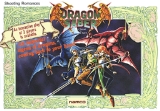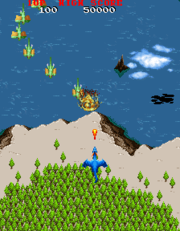
Dragon Saber
Encyclopedia
Dragon Saber is a vertical scrolling shooter arcade game
that was released by Namco
in 1990. It is the sequel to Dragon Spirit
, released three years earlier.
 As in the original Dragon Spirit, the player controls a dragon who shoots at air-based enemies and bombs ground-based enemies, except this time two players can play simultaneously - player one controls Huey (the blue dragon) while player two controls Siria (the red dragon).
As in the original Dragon Spirit, the player controls a dragon who shoots at air-based enemies and bombs ground-based enemies, except this time two players can play simultaneously - player one controls Huey (the blue dragon) while player two controls Siria (the red dragon).
Arcade game
An arcade game is a coin-operated entertainment machine, usually installed in public businesses such as restaurants, bars, and amusement arcades. Most arcade games are video games, pinball machines, electro-mechanical games, redemption games, and merchandisers...
that was released by Namco
Namco
is a Japanese corporation best known as a former video game developer and publisher. Following a merger with Bandai in September 2005, the two companies' game production assets were spun off into Namco Bandai Games on March 31, 2006. Namco Ltd. was re-established to continue domestic operation of...
in 1990. It is the sequel to Dragon Spirit
Dragon Spirit
Dragon Spirit is a 1987 vertical scrolling shooter arcade game released by Namco and Atari Games . It runs on Namco System 1 hardware, and was later ported to the Nintendo Entertainment System, Amstrad CPC, Commodore Amiga, Commodore 64, DOS, Atari ST, Sharp X68000, TurboGrafx-16 and ZX Spectrum...
, released three years earlier.
Story
The human beings have repeated their own foolish history, because of their own desires. And everything around then has amounted to come to nothing. Advanced alchemy has caused environmental disruption. The world has been filled with evil creatures. And the human beings have threatened with extinction. Meanwhile, the sun god, Amaterasu appeared from the sky to human, and told. "The brave young man Huey and Siria. I grant you this sacred saber." "Show your good spirit!"Gameplay


